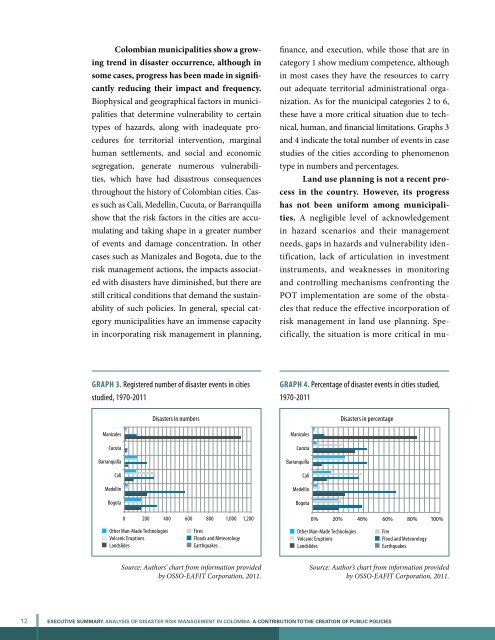Executive Summary - GFDRR
Executive Summary - GFDRR
Executive Summary - GFDRR
You also want an ePaper? Increase the reach of your titles
YUMPU automatically turns print PDFs into web optimized ePapers that Google loves.
Colombian municipalities show a growing<br />
trend in disaster occurrence, although in<br />
some cases, progress has been made in significantly<br />
reducing their impact and frequency.<br />
Biophysical and geographical factors in municipalities<br />
that determine vulnerability to certain<br />
types of hazards, along with inadequate procedures<br />
for territorial intervention, marginal<br />
human settlements, and social and economic<br />
segregation, generate numerous vulnerabilities,<br />
which have had disastrous consequences<br />
throughout the history of Colombian cities. Cases<br />
such as Cali, Medellin, Cucuta, or Barranquilla<br />
show that the risk factors in the cities are accumulating<br />
and taking shape in a greater number<br />
of events and damage concentration. In other<br />
cases such as Manizales and Bogota, due to the<br />
risk management actions, the impacts associated<br />
with disasters have diminished, but there are<br />
still critical conditions that demand the sustainability<br />
of such policies. In general, special category<br />
municipalities have an immense capacity<br />
in incorporating risk management in planning,<br />
finance, and execution, while those that are in<br />
category 1 show medium competence, although<br />
in most cases they have the resources to carry<br />
out adequate territorial administrational organization.<br />
As for the municipal categories 2 to 6,<br />
these have a more critical situation due to technical,<br />
human, and financial limitations. Graphs 3<br />
and 4 indicate the total number of events in case<br />
studies of the cities according to phenomenon<br />
type in numbers and percentages.<br />
Land use planning is not a recent process<br />
in the country. However, its progress<br />
has not been uniform among municipalities.<br />
A negligible level of acknowledgement<br />
in hazard scenarios and their management<br />
needs, gaps in hazards and vulnerability identification,<br />
lack of articulation in investment<br />
instruments, and weaknesses in monitoring<br />
and controlling mechanisms confronting the<br />
POT implementation are some of the obstacles<br />
that reduce the effective incorporation of<br />
risk management in land use planning. Specifically,<br />
the situation is more critical in mu-<br />
Graph 3. Registered number of disaster events in cities<br />
studied, 1970-2011<br />
Graph 4. Percentage of disaster events in cities studied,<br />
1970-2011<br />
Disasters in numbers<br />
Manizales<br />
Cucuta<br />
Barranquilla<br />
Cali<br />
Medellin<br />
Bogota<br />
0 200 400 600 800 1,000 1,200<br />
Disasters in percentage<br />
Manizales<br />
Cucuta<br />
Barranquilla<br />
Cali<br />
Medellin<br />
Bogota<br />
0% 20% 40% 60% 80% 100%<br />
Other Man-Made Technologies<br />
Volcanic Eruptions<br />
Landslides<br />
Fires<br />
Floods and Meteorology<br />
Earthquakes<br />
Other Man-Made Technologies<br />
Volcanic Eruptions<br />
Landslides<br />
Fire<br />
Flood and Meteorology<br />
Earthquakes<br />
Source: Authors’ chart from information provided<br />
by OSSO-EAFIT Corporation, 2011.<br />
Source: Author’s chart from information provided<br />
by OSSO-EAFIT Corporation, 2011.<br />
12 EXECUTIVE SUMMARY. ANALYSIS OF DISASTER RISK MANAGEMENT IN COLOMBIA: A contribution TO the creation of public policies

















